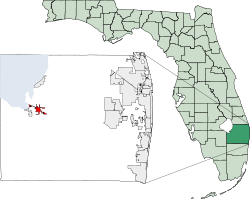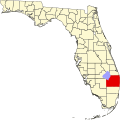Belle Glade, Florida | |
|---|---|
| City of Belle Glade | |
 Main Street in Belle Glade | |
| Nickname: | |
| Motto: Her Soil is Her Fortune | |
 Location of Belle Glade in Florida | |
| Coordinates: 26°41′07″N80°40′17″W / 26.68528°N 80.67139°W | |
| Country | |
| State | |
| County | |
| Settled (Hillsboro Settlement) | c. 1912–April 8, 1928 [3] [4] [5] [6] [7] [8] |
| Incorporated (Town of Belle Glade) | April 9, 1928 [3] [4] [5] [6] [7] [8] |
| Incorporated (City of Belle Glade) | September 11, 1945 [3] [4] [5] [6] [7] [8] |
| Government | |
| • Type | Commissioner-Manager |
| • Mayor | Steve B. Wilson |
| • Vice Mayor | Joaquin Almazan |
| • Commissioners | Mary Ross Wilkerson, Andrew L. Berry, and City Treasurer Zayteck D. Marin |
| • City Manager | Diana Hughes |
| • City Clerk | Jessica Figueroa |
| Area | |
• Total | 7.03 sq mi (18.21 km2) |
| • Land | 6.97 sq mi (18.06 km2) |
| • Water | 0.058 sq mi (0.15 km2) |
| Elevation | 16 ft (4.9 m) |
| Population (2020) | |
• Total | 16,698 |
| • Density | 2,394.9/sq mi (924.66/km2) |
| Time zone | UTC-5 (Eastern (EST)) |
| • Summer (DST) | UTC-4 (EDT) |
| ZIP code | 33430 |
| Area codes | 561, 728 |
| FIPS code | 12-05200 [11] |
| GNIS feature ID | 0278445 [10] |
| Website | http://www.bellegladegov.com/ |
Belle Glade is a city in south-central Florida in the far western part of Palm Beach County, Florida, United States, on the southeastern shore of Lake Okeechobee. It is part of the Miami metropolitan area of South Florida. According to the 2020 U.S. census, the city had a population of 16,698, down from 17,467 in the 2010 census.
Contents
- History
- Pre-historic
- Settlement
- 1928 hurricane
- World War II
- HIV/AIDS
- In recent years
- Geography
- Climate
- Demographics
- 2020 census
- 2010 census
- 2000 census
- Economy
- Parks and recreation
- Education
- Elementary schools
- Middle schools
- High schools
- Private schools
- College
- Notable people
- In popular culture
- See also
- References
- External links
Belle Glade (and the surrounding area) is sometimes referred to as "Muck City" due to the large quantity of muck, in which sugarcane grows, found in the area. [1] Despite being located in the South Florida region of the state, Belle Glade is culturally more associated with the Florida Heartland.
For a time during the early to mid 1980s, the city had the highest rate of AIDS infection per capita (37 cases in a population of roughly 19,000) in the United States. [12] According to the FBI, in 2003, the city had the second highest violent crime rate in the country at 298 per 10,000 residents.[ citation needed ] In 2010, the Palm Beach County sheriff's office estimated that half of the young men in Belle Glade between the ages of 18 and 25 had felony convictions. [13]







